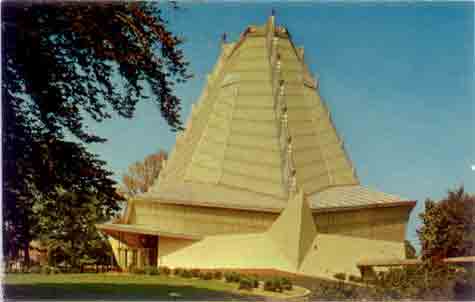SYNAGOGUES: MODERNITY
Later version of synagogue architecture continued to walk
this line between Jewish distinctiveness and cultural integration (sometimes
called "assimilation," which often has a negative connotation).
This has been particularly noticeable in the modern
period, when Jews finally achieved real social and political integration into
the modern western nation-state. Synagogue construction in the United
States has often been an exercise in "normalizing" Judaism as a public religion.
 Some
synagogues, like this nineteenth-century synagogue in Charleston, South Carolina, attempted to portray
Jewish religious identity as solemn and
dignified, like upper-class white Protestant religions. The neo-classical
form chosen here is meant to represent stately and serene American religious
identity.
Some
synagogues, like this nineteenth-century synagogue in Charleston, South Carolina, attempted to portray
Jewish religious identity as solemn and
dignified, like upper-class white Protestant religions. The neo-classical
form chosen here is meant to represent stately and serene American religious
identity.
Other synagogues chose to emphasize the particularity of
Jewish tradition, often in exaggerated, stereotypical forms:
 This
synagogue, from Hartford, Connecticut, was constructed in the "Byzantine" style:
Jewish identity here is presented as an "eastern" or "oriental" tradition,
highlighting the degree to which Jewish identity remains distinct from (and yet
integrated into) the religious landscape of the United States (notice that the
landscape is still formally "western": carefully sculpted pine trees and an immaculately manicured lawn).
This
synagogue, from Hartford, Connecticut, was constructed in the "Byzantine" style:
Jewish identity here is presented as an "eastern" or "oriental" tradition,
highlighting the degree to which Jewish identity remains distinct from (and yet
integrated into) the religious landscape of the United States (notice that the
landscape is still formally "western": carefully sculpted pine trees and an immaculately manicured lawn).
Sometimes synagogue architecture abandoned Jewish
particularity or integration into a western ideal altogether: like other
public structures of the post-World War Two period, Jewish synagogues could be
designed to project an image of artistry and creativity, as in this synagogue designed by famed architect
Frank Lloyd Wright:
 Wright
intended this to be a building rich with Jewish imagery: the base is a
six-pointed star (the "Star of David") and the structure is meant to evoke
Mount Sinai, where Moses received the law. As a public building, however, the
artistic uniqueness is what most stands out, and in this the Jewish community
was striving for a sense of creative expression common in American post-war
cultural identity.
Wright
intended this to be a building rich with Jewish imagery: the base is a
six-pointed star (the "Star of David") and the structure is meant to evoke
Mount Sinai, where Moses received the law. As a public building, however, the
artistic uniqueness is what most stands out, and in this the Jewish community
was striving for a sense of creative expression common in American post-war
cultural identity.
continue with slideshow
 Some
synagogues, like this nineteenth-century synagogue in Charleston, South Carolina, attempted to portray
Jewish religious identity as solemn and
dignified, like upper-class white Protestant religions. The neo-classical
form chosen here is meant to represent stately and serene American religious
identity.
Some
synagogues, like this nineteenth-century synagogue in Charleston, South Carolina, attempted to portray
Jewish religious identity as solemn and
dignified, like upper-class white Protestant religions. The neo-classical
form chosen here is meant to represent stately and serene American religious
identity. This
synagogue, from Hartford, Connecticut, was constructed in the "Byzantine" style:
Jewish identity here is presented as an "eastern" or "oriental" tradition,
highlighting the degree to which Jewish identity remains distinct from (and yet
integrated into) the religious landscape of the United States (notice that the
landscape is still formally "western": carefully sculpted pine trees and an immaculately manicured lawn).
This
synagogue, from Hartford, Connecticut, was constructed in the "Byzantine" style:
Jewish identity here is presented as an "eastern" or "oriental" tradition,
highlighting the degree to which Jewish identity remains distinct from (and yet
integrated into) the religious landscape of the United States (notice that the
landscape is still formally "western": carefully sculpted pine trees and an immaculately manicured lawn).  Wright
intended this to be a building rich with Jewish imagery: the base is a
six-pointed star (the "Star of David") and the structure is meant to evoke
Mount Sinai, where Moses received the law. As a public building, however, the
artistic uniqueness is what most stands out, and in this the Jewish community
was striving for a sense of creative expression common in American post-war
cultural identity.
Wright
intended this to be a building rich with Jewish imagery: the base is a
six-pointed star (the "Star of David") and the structure is meant to evoke
Mount Sinai, where Moses received the law. As a public building, however, the
artistic uniqueness is what most stands out, and in this the Jewish community
was striving for a sense of creative expression common in American post-war
cultural identity.